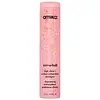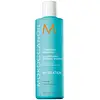What's inside
What's inside
 Key Ingredients
Key Ingredients

 Benefits
Benefits

 Concerns
Concerns

 Ingredients Side-by-side
Ingredients Side-by-side

Water
Skin ConditioningSodium Cocoyl Isethionate
CleansingCocamidopropyl Hydroxysultaine
CleansingCocamidopropyl Betaine
CleansingGlycerin
HumectantCocamide Mipa
EmulsifyingHippophae Rhamnoides Fruit/Seed Oil
AntimicrobialPentaclethra Macroloba Seed Oil
EmollientRubus Idaeus Leaf Extract
Skin ConditioningMagnolia Officinalis Bark Extract
AntimicrobialZingiber Officinale Root Extract
MaskingVitis Vinifera Leaf Extract
Skin ConditioningWine Extract
AntioxidantLactobacillus Ferment
Skin ConditioningCaprylic/Capric Triglyceride
MaskingGlycol Distearate
EmollientPolyquaternium-7
Guar Hydroxypropyltrimonium Chloride
Skin ConditioningTetrasodium Glutamate Diacetate
Citric Acid
BufferingPropylene Glycol
HumectantPhenoxyethanol
PreservativeEthylhexylglycerin
Skin ConditioningSodium Chloride
MaskingSodium Hydroxide
BufferingParfum
MaskingBenzyl Benzoate
AntimicrobialHydroxycitronellal
PerfumingLimonene
PerfumingWater, Sodium Cocoyl Isethionate, Cocamidopropyl Hydroxysultaine, Cocamidopropyl Betaine, Glycerin, Cocamide Mipa, Hippophae Rhamnoides Fruit/Seed Oil, Pentaclethra Macroloba Seed Oil, Rubus Idaeus Leaf Extract, Magnolia Officinalis Bark Extract, Zingiber Officinale Root Extract, Vitis Vinifera Leaf Extract, Wine Extract, Lactobacillus Ferment, Caprylic/Capric Triglyceride, Glycol Distearate, Polyquaternium-7, Guar Hydroxypropyltrimonium Chloride, Tetrasodium Glutamate Diacetate, Citric Acid, Propylene Glycol, Phenoxyethanol, Ethylhexylglycerin, Sodium Chloride, Sodium Hydroxide, Parfum, Benzyl Benzoate, Hydroxycitronellal, Limonene
Water
Skin ConditioningSodium Lauroyl Sarcosinate
CleansingCocamidopropyl Hydroxysultaine
CleansingCocamidopropyl Betaine
CleansingParfum
MaskingLactamide Mea
HumectantGlycerin
HumectantAcrylates/Palmeth-25 Acrylate Copolymer
Argania Spinosa Kernel Oil
EmollientChondrus Crispus Extract
Skin ConditioningAscophyllum Nodosum Extract
Skin ConditioningLaminaria Saccharina Extract
Skin ProtectingPalmaria Palmata Extract
Skin ProtectingUndaria Pinnatifida Extract
Skin ConditioningXylitylglucoside
HumectantPEG-150 Pentaerythrityl Tetrastearate
EmulsifyingAnhydroxylitol
HumectantSodium PCA
HumectantStyrene/Acrylates Copolymer
PEG-6 Caprylic/Capric Glycerides
EmulsifyingCitric Acid
BufferingLauric Acid
CleansingPolyquaternium-7
Propylene Glycol
HumectantXylitol
HumectantSodium Sarcosinate
Tetrasodium EDTA
Polysorbate 20
EmulsifyingDisodium EDTA
Ethylhexylglycerin
Skin ConditioningPEG-20 Glyceryl Laurate
EmulsifyingGlucose
HumectantTocopherol
AntioxidantLinoleic Acid
CleansingRetinyl Palmitate
Skin ConditioningCaprylic/Capric Triglyceride
MaskingDiethylhexyl Syringylidenemalonate
Skin ProtectingPhenoxyethanol
PreservativeSodium Benzoate
MaskingPotassium Sorbate
PreservativeChlorphenesin
AntimicrobialAlpha-Isomethyl Ionone
PerfumingLinalool
PerfumingHydroxycitronellal
PerfumingWater, Sodium Lauroyl Sarcosinate, Cocamidopropyl Hydroxysultaine, Cocamidopropyl Betaine, Parfum, Lactamide Mea, Glycerin, Acrylates/Palmeth-25 Acrylate Copolymer, Argania Spinosa Kernel Oil, Chondrus Crispus Extract, Ascophyllum Nodosum Extract, Laminaria Saccharina Extract, Palmaria Palmata Extract, Undaria Pinnatifida Extract, Xylitylglucoside, PEG-150 Pentaerythrityl Tetrastearate, Anhydroxylitol, Sodium PCA, Styrene/Acrylates Copolymer, PEG-6 Caprylic/Capric Glycerides, Citric Acid, Lauric Acid, Polyquaternium-7, Propylene Glycol, Xylitol, Sodium Sarcosinate, Tetrasodium EDTA, Polysorbate 20, Disodium EDTA, Ethylhexylglycerin, PEG-20 Glyceryl Laurate, Glucose, Tocopherol, Linoleic Acid, Retinyl Palmitate, Caprylic/Capric Triglyceride, Diethylhexyl Syringylidenemalonate, Phenoxyethanol, Sodium Benzoate, Potassium Sorbate, Chlorphenesin, Alpha-Isomethyl Ionone, Linalool, Hydroxycitronellal
 Reviews
Reviews

Ingredients Explained
These ingredients are found in both products.
Ingredients higher up in an ingredient list are typically present in a larger amount.
This ingredient is an emollient, solvent, and texture enhancer. It is considered a skin-softener by helping the skin prevent moisture loss.
It helps thicken a product's formula and makes it easier to spread by dissolving clumping compounds.
Caprylic Triglyceride is made by combining glycerin with coconut oil, forming a clear liquid.
While there is an assumption Caprylic Triglyceride can clog pores due to it being derived from coconut oil, there is no research supporting this.
Learn more about Caprylic/Capric TriglycerideCitric Acid is an alpha hydroxy acid (AHA) naturally found in citrus fruits like oranges, lemons, and limes.
Like other AHAs, citric acid can exfoliate skin by breaking down the bonds that hold dead skin cells together. This helps reveal smoother and brighter skin underneath.
However, this exfoliating effect only happens at high concentrations (20%) which can be hard to find in cosmetic products.
Due to this, citric acid is usually included in small amounts as a pH adjuster. This helps keep products slightly more acidic and compatible with skin's natural pH.
In skincare formulas, citric acid can:
While it can provide some skin benefits, research shows lactic acid and glycolic acid are generally more effective and less irritating exfoliants.
Most citric acid used in skincare today is made by fermenting sugars (usually from molasses). This synthetic version is identical to the natural citrus form but easier to stabilize and use in formulations.
Read more about some other popular AHA's here:
Learn more about Citric AcidCocamidopropyl Betaine is a fatty acid created by mixing similar compounds in coconut oil and dimethylaminopropylamine, a compound with two amino groups.
This ingredient is a surfactant and cleanser. It helps gather the dirt, pollutants, and other impurities in your skin to be washed away. It also helps thicken a product and make the texture more creamy.
Being created from coconut oil means Cocamidopropyl Betaine is hydrating for the skin.
While Cocamidopropyl Betaine was believed to be an allergen, a study from 2012 disproved this. It found two compounds in unpure Cocamidopropyl Betaine to be the irritants: aminoamide and 3-dimethylaminopropylamine. High-grade and pure Cocamidopropyl Betaine did not induce allergic reactions during this study.
Learn more about Cocamidopropyl BetaineCocamidopropyl Hydroxysultaine is a synthetic cleansing agent, though it is derived from coconut oil.
It is used to enhance the texture of products by boosting lather and thickening the texture. As a cleanser, Cocamidopropyl Hydroxysultaine is mild.
Ethylhexylglycerin (we can't pronounce this either) is commonly used as a preservative and skin softener. It is derived from glyceryl.
You might see Ethylhexylglycerin often paired with other preservatives such as phenoxyethanol. Ethylhexylglycerin has been found to increase the effectiveness of these other preservatives.
Glycerin is already naturally found in your skin. It helps moisturize and protect your skin.
A study from 2016 found glycerin to be more effective as a humectant than AHAs and hyaluronic acid.
As a humectant, it helps the skin stay hydrated by pulling moisture to your skin. The low molecular weight of glycerin allows it to pull moisture into the deeper layers of your skin.
Hydrated skin improves your skin barrier; Your skin barrier helps protect against irritants and bacteria.
Glycerin has also been found to have antimicrobial and antiviral properties. Due to these properties, glycerin is often used in wound and burn treatments.
In cosmetics, glycerin is usually derived from plants such as soybean or palm. However, it can also be sourced from animals, such as tallow or animal fat.
This ingredient is organic, colorless, odorless, and non-toxic.
Glycerin is the name for this ingredient in American English. British English uses Glycerol/Glycerine.
Learn more about GlycerinHydroxycitronellal is a fragrance created from citronellal. The smell of hydroxycitronellal is often described as "citrus-like" or "melon-like".
Hydroxycitronellal is a known EU allergen and may cause irritation when applied to the skin.
Parfum is a catch-all term for an ingredient or more that is used to give a scent to products.
Also called "fragrance", this ingredient can be a blend of hundreds of chemicals or plant oils. This means every product with "fragrance" or "parfum" in the ingredients list is a different mixture.
For instance, Habanolide is a proprietary trade name for a specific aroma chemical. When used as a fragrance ingredient in cosmetics, most aroma chemicals fall under the broad labeling category of “FRAGRANCE” or “PARFUM” according to EU and US regulations.
The term 'parfum' or 'fragrance' is not regulated in many countries. In many cases, it is up to the brand to define this term.
For instance, many brands choose to label themselves as "fragrance-free" because they are not using synthetic fragrances. However, their products may still contain ingredients such as essential oils that are considered a fragrance by INCI standards.
One example is Calendula flower extract. Calendula is an essential oil that still imparts a scent or 'fragrance'.
Depending on the blend, the ingredients in the mixture can cause allergies and sensitivities on the skin. Some ingredients that are known EU allergens include linalool and citronellol.
Parfum can also be used to mask or cover an unpleasant scent.
The bottom line is: not all fragrances/parfum/ingredients are created equally. If you are worried about fragrances, we recommend taking a closer look at an ingredient. And of course, we always recommend speaking with a professional.
Learn more about ParfumPhenoxyethanol is a preservative that has germicide, antimicrobial, and aromatic properties. Studies show that phenoxyethanol can prevent microbial growth. By itself, it has a scent that is similar to that of a rose.
It's often used in formulations along with Caprylyl Glycol to preserve the shelf life of products.
Polyquaternium-7 is a light to clear colored liquid. It is commonly found in haircare products for its film-forming and anti-static properties.
According to a manufacturer, it is a non-paraben and specially developed for negatively charged surfactant systems. This makes it a great hairstyle holder and helps to improve wet hair detangling without adding buildup.
Propylene Glycol is an odorless, colorless liquid. As a humectant, it helps skin retain moisture. It also aids in delivering active ingredients.
Another role of this ingredient is preventing a product from melting or freezing. Propylene glycol also adds antimicrobrial properties to a product, elongating product lifespan.
This ingredient is considered an organic alcohol and commonly added into both cosmetics and foods.
Those with sensitive skin or conditions may develop a rash when using this ingredient.
Learn more about Propylene GlycolWater. It's the most common cosmetic ingredient of all. You'll usually see it at the top of ingredient lists, meaning that it makes up the largest part of the product.
So why is it so popular? Water most often acts as a solvent - this means that it helps dissolve other ingredients into the formulation.
You'll also recognize water as that liquid we all need to stay alive. If you see this, drink a glass of water. Stay hydrated!
Learn more about Water